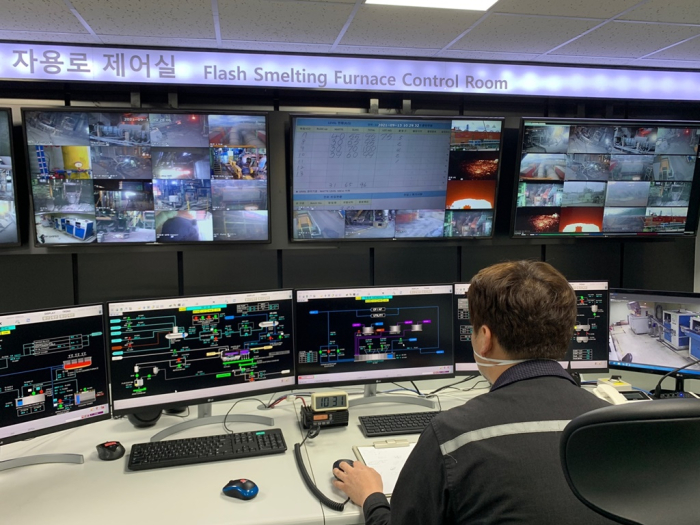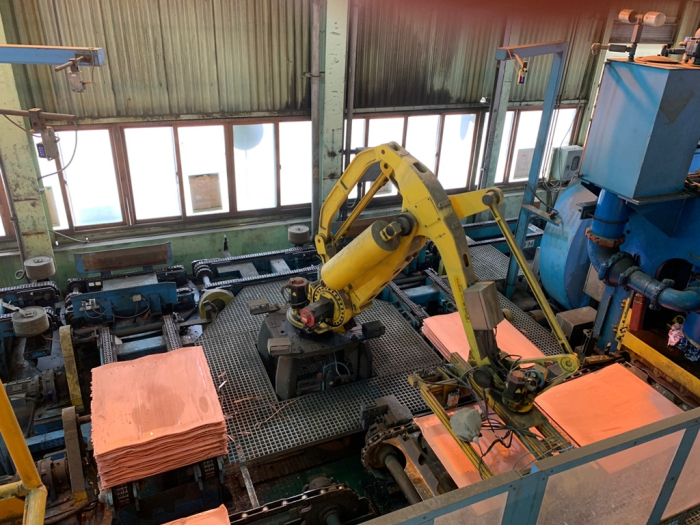Copper
LS-Nikko to boost profit by 4-6% with smart factory
ODS project to help cut costs by up to $12.8 million a year from 2024
By Sep 22, 2021 (Gmt+09:00)
4
Min read
Most Read
LG Chem to sell water filter business to Glenwood PE for $692 million


Kyobo Life poised to buy Japan’s SBI Group-owned savings bank


KT&G eyes overseas M&A after rejecting activist fund's offer


StockX in merger talks with Naver’s online reseller Kream


Mirae Asset to be named Korea Post’s core real estate fund operator



LS-Nikko Copper Inc., the world’s second-largest electrolytic copper maker, is beginning to reap the rewards of its smart factory project began in 2019. The only copper smelter in South Korea is expected to increase operating profits by 4-6% once the project is completed in 2024.
The flash-smelting furnace control room at LS-Nikko’s Onsan plant in Ulsan, 415 kilometers southeast of Seoul, is filled with monitors showing data on voltage, temperature and flow rate of thousands of facilities throughout the complex. One of the monitors displayed real-time information on hundreds of vessels loaded with copper concentrate heading to the Onsan port from the globe. The company is able to check the total copper content in the raw material just with one click.
“We manage the yield by keeping the copper content in the raw material constantly used in the smelting facilities, utilizing data on raw material warehousing,” said Park Sung-sil, LS-Nikko’s senior vice president and head of technology department, said on Sept. 14. “This is the fruit of a project to establish a smart factory we’ve been working on for the last two years.”
The Onsan plant with an annual electrolytic copper capacity of 680,000 tons processes raw materials from about 10 countries in the world including Indonesia, Chile and Peru to manufacture copper, gold, silver and palladium.
ODS PROJECT TO DIGITALIZE AND AUTOMATE WHOLE PROCESS
LS-Nikko was set to spend 50 billion won ($42.7 million) by 2024 on the ODS (Onsan Digital Smart factory) project to digitalize and automate the whole process from raw material warehousing to product shipments.
The joint venture between LS Group and Japan Korea Joint Smelting (JKJS) last year adopted manufacturing enterprise system (MES) and advanced planning & scheduling (APS), the first phase of the ODS project to collect about 40,000 data generated from thousands of equipment in the plant. It optimized parts of production process including raw material mixtures and output adjustments.
The second and the third phases to be started in the first half of 2022 are process to apply the data to production. The second phase is to derive optimal solutions for each process, utilizing artificial intelligence (AI) technology. In the final third phase, it is a goal to adopt digital twin technology that allows the company to make a digital replica of a real production process. It is the ideal of a smart factory that maximizes productivity by attempting experiments that are difficult to do in reality through simulation in virtual space.

TO SAVE UP TO $12.8 MILLION A YEAR
The project already started bearing fruit. LS-Nikko expected to cut costs by 6 billion won this year after slashing 2 billion won in 2020.
The company born in 1936 is predicted to lower expenses by 10 billion-15 billion won a year from 2024 when the second stage of the project is settled, about 4-6% of its average operating profit of 250 billion won over the past ten years.
“The production innovation always leads to a higher operating profit,” said Jeon Dong-hyuk, a manager for the ODS completion task force team. “It will help to overcome the highly volatile non-ferrous metal cycle.”
LS-Nikko sought the project to survive amid an intensifying competition in the copper smelter industry. Global electrolytic copper prices jumped to $9,000-10,000 a ton this year from around $6,000 in 2020. But treatment charges, a key profit source for smelters, were around $50 a ton, halving in five years, due to cut-throat competition following construction of major plants in Asian countries such as China and Indonesia.
The company’s earnings have been deteriorating. Its operating profit for this year was forecast at around 200 billion won, compared with 228.5 billion won in 2020 and 315.4 billion won in 2019.
LS-Nikko is also reinforcing environmental, social and governance (ESG) management with a plan to invest 120 billion won in environmental and safety sectors. It already spent 50 billion won for adding dust collecting facilities to prevent the leakage of harmful substances from the smelter in advance and improve air quality.
“Environmental and safety management is directly related to productivity at a smelter which should not stop 24 hours a day,” said the company’s CEO Doh Suk-goo. “We will have the world's best ESG capabilities through preemptive investment."
Write to Jung-hwan Hwang at jung@hankyung.com
Jongwoo Cheon edited this article.
More to Read
-
 Business & PoliticsTrump Jr. meets Korean business chiefs in back-to-back sessions
Business & PoliticsTrump Jr. meets Korean business chiefs in back-to-back sessionsApr 30, 2025 (Gmt+09:00)
-
 Korean chipmakersSamsung in talks to supply customized HBM4 to Nvidia, Broadcom, Google
Korean chipmakersSamsung in talks to supply customized HBM4 to Nvidia, Broadcom, GoogleApr 30, 2025 (Gmt+09:00)
-
 EnergyLS Cable breaks ground on $681 mn underwater cable plant in Chesapeake
EnergyLS Cable breaks ground on $681 mn underwater cable plant in ChesapeakeApr 29, 2025 (Gmt+09:00)
-
 Business & PoliticsUS tariffs add risk premium to dollar assets: Maurice Obstfeld
Business & PoliticsUS tariffs add risk premium to dollar assets: Maurice ObstfeldApr 29, 2025 (Gmt+09:00)
-

Comment 0
LOG IN


